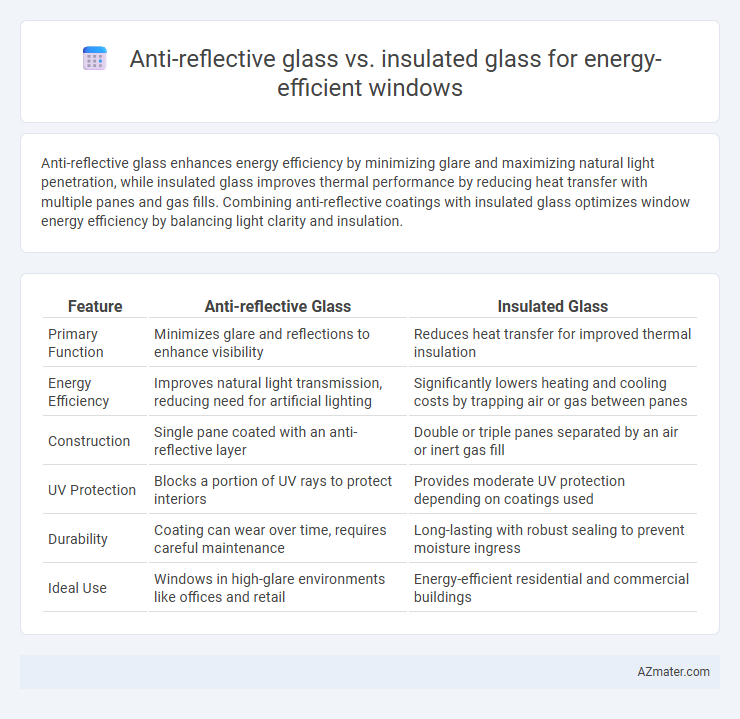Anti-reflective glass enhances energy efficiency by minimizing glare and maximizing natural light penetration, while insulated glass improves thermal performance by reducing heat transfer with multiple panes and gas fills. Combining anti-reflective coatings with insulated glass optimizes window energy efficiency by balancing light clarity and insulation.
Table of Comparison
| Feature | Anti-reflective Glass | Insulated Glass |
|---|---|---|
| Primary Function | Minimizes glare and reflections to enhance visibility | Reduces heat transfer for improved thermal insulation |
| Energy Efficiency | Improves natural light transmission, reducing need for artificial lighting | Significantly lowers heating and cooling costs by trapping air or gas between panes |
| Construction | Single pane coated with an anti-reflective layer | Double or triple panes separated by an air or inert gas fill |
| UV Protection | Blocks a portion of UV rays to protect interiors | Provides moderate UV protection depending on coatings used |
| Durability | Coating can wear over time, requires careful maintenance | Long-lasting with robust sealing to prevent moisture ingress |
| Ideal Use | Windows in high-glare environments like offices and retail | Energy-efficient residential and commercial buildings |
Introduction to Energy-Efficient Windows
Energy-efficient windows utilize materials like anti-reflective glass and insulated glass to reduce heat transfer and enhance indoor comfort. Anti-reflective glass minimizes glare and improves light transmission, while insulated glass combines multiple panes with air or gas fills to provide superior thermal insulation. Both technologies contribute significantly to lowering energy consumption and improving overall building efficiency.
What is Anti-Reflective Glass?
Anti-reflective glass is engineered with a specialized coating that reduces surface reflections, enhancing light transmission and improving visibility through windows. This glass type significantly minimizes glare while maximizing solar heat gain, contributing to energy efficiency in buildings. Compared to insulated glass, which primarily focuses on thermal insulation through multiple glass layers, anti-reflective glass optimizes natural light utilization and reduces reliance on artificial lighting.
What is Insulated Glass?
Insulated glass consists of two or more glass panes separated by a spacer and sealed to create a thermally efficient unit that reduces heat transfer and enhances energy performance. This design minimizes heat loss in winter and heat gain in summer, improving indoor comfort and lowering energy bills. Compared to anti-reflective glass, insulated glass primarily focuses on thermal insulation rather than glare reduction.
How Anti-Reflective Glass Improves Energy Efficiency
Anti-reflective glass enhances energy efficiency by minimizing solar heat gain and reducing glare, allowing natural light to penetrate without excessive heat buildup. This glass increases the visible light transmission while limiting ultraviolet and infrared rays, leading to lower cooling costs in warm climates. Compared to insulated glass, which relies on dual panes and gas fills to reduce heat transfer, anti-reflective coatings optimize daylight utilization and improve occupant comfort through glare control.
Insulated Glass: Thermal Performance and Benefits
Insulated glass significantly enhances thermal performance in energy-efficient windows by incorporating multiple glass panes separated by a spacer filled with air or inert gas, reducing heat transfer and minimizing energy loss. This design improves indoor temperature regulation, lowers heating and cooling costs, and enhances overall comfort by preventing drafts and condensation. Its superior insulation properties make insulated glass a preferred choice for sustainable building solutions focused on energy efficiency and environmental impact reduction.
Comparison: Anti-Reflective vs Insulated Glass
Anti-reflective glass improves energy efficiency by reducing glare and enhancing light transmission, which boosts natural daylight and lowers reliance on artificial lighting. Insulated glass, featuring multiple panes separated by air or gas-filled spaces, provides superior thermal insulation, minimizing heat transfer and reducing heating and cooling costs. While anti-reflective glass maximizes visibility and comfort, insulated glass primarily targets thermal performance and energy savings in windows.
Cost Considerations for Each Glass Type
Anti-reflective glass typically costs more upfront due to advanced coatings designed to reduce glare and improve solar control, enhancing energy efficiency by allowing more natural light while minimizing heat gain. Insulated glass, consisting of two or more panes separated by a gas-filled space, has higher initial installation expenses but offers superior thermal insulation, potentially lowering heating and cooling costs over time. Evaluating long-term energy savings against installation and maintenance costs is essential for choosing the most cost-effective energy-efficient window solution.
Durability and Maintenance Differences
Anti-reflective glass features a specialized coating to reduce glare and improve light transmission, but it requires regular cleaning and care to maintain its coating's effectiveness and can be more prone to surface scratches. Insulated glass, composed of multiple panes separated by air or gas-filled spaces, offers superior durability against environmental stress due to its sealed units and requires minimal maintenance since the protective seal prevents moisture ingress and fogging. While anti-reflective glass enhances visual comfort, insulated glass provides greater long-term reliability and lower upkeep costs in energy-efficient window applications.
Best Applications for Anti-Reflective and Insulated Glass
Anti-reflective glass excels in environments requiring maximum natural light with minimal glare, ideal for commercial storefronts, museums, and solar panels. Insulated glass, consisting of multiple panes with gas fills and low-emissivity coatings, is best suited for residential and commercial buildings demanding superior thermal insulation and energy savings. Combining these technologies enhances window performance, but selecting between them depends on prioritizing light transmission or insulation efficiency.
Choosing the Right Glass for Energy-Efficient Windows
Anti-reflective glass minimizes glare and improves solar heat gain control, making it ideal for maximizing natural light while reducing cooling costs. Insulated glass, composed of two or more glass panes separated by a vacuum or gas-filled space, enhances thermal insulation significantly and reduces heat transfer. Choosing the right glass depends on climate conditions, window orientation, and energy efficiency goals to balance light transmission and thermal performance effectively.

Infographic: Anti-reflective glass vs Insulated glass for Energy-efficient window
 azmater.com
azmater.com